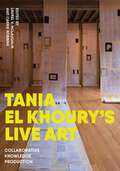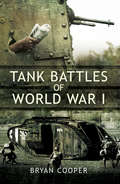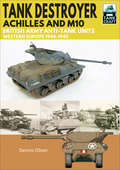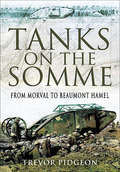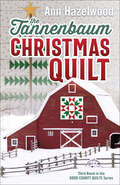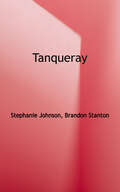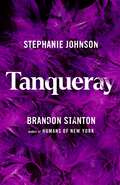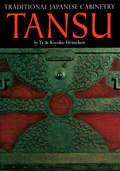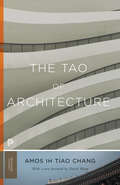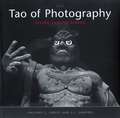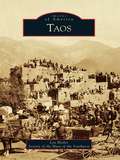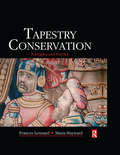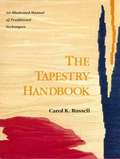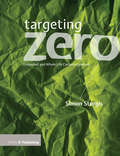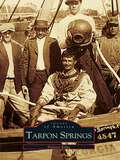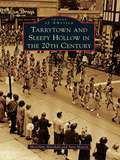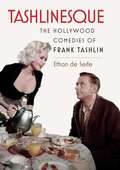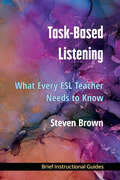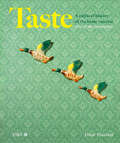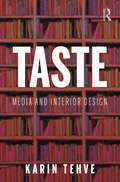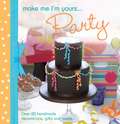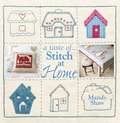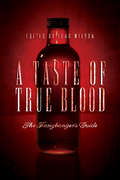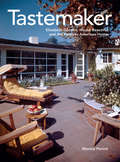- Table View
- List View
Tania El Khoury's Live Art: Collaborative Knowledge Production
by Carrie RobbinsTania El Khoury’s Live Art is the first book to examine the work of Tania El Khoury, a “live” artist deeply engaged in the politics and histories of the South West Asia and North Africa (SWANA) region. Since the 2011 Syrian uprisings, El Khoury has conceived and created works about lived experiences at and across international borders in collaboration with migrants, refugees, and displaced persons as well as other artists, performers, and revolutionaries. All of El Khoury’s works cross borders: between forms of artistic practice, between artists and audiences, and between art and activism. Facilitating critical dialogue about the politics of SWANA and the impact of globalization, her performances and installations also test the boundaries of aesthetic, political, and everyday norms. This interdisciplinary and multimedia reader features essays by artists, curators, and scholars who explore the dynamic possibilities and complexities of El Khoury’s art. From social workers to archeologists to archivists, contributing authors engage with the radical epistemological and political revolutions that El Khoury and her collaborators invite us all to join.
Tank Battles of World War I
by Bryan CooperFailure to exploit the potential of an original idea is a recurring phenomenon in our national history. Few failures, however, can have been so costly in human life as that of our military commanders early in 1916 to appreciate that the tank was a war winning weapon. The slaughter of the Somme, Passchendaele and Ypres salient had to be endured before accepted 'conventional' methods were abandoned and the tank given a chance. Bryan Cooper describes the early tank actions in vivid detail, with many eye-witness accounts. He tells of the courage and endurance of the crews not just in battle but in the appalling conditions in which they had to drive and fight their primitive vehicles. Scalded, scorched and poisoned with exhaust fumes, constantly threatened with being burned to death, these crews eventually laid the foundation for the Allied Victory in World War I. The book is well illustrated with many original photographs which give the present day reader a glimpse of the infancy of a dominant weapon of modern war.
Tank Destroyer, Achilles and M10: British Army Anti-Tank Units, Western Europe, 1944–1945 (TankCraft)
by Dennis OliverA guide that blends the history behind this British World War II tank with resources for military vehicle modeling enthusiasts. In this heavily illustrated volume in the TankCraft series Dennis Oliver focuses on the Achilles—the British variant of the American M10—which was one of the most important Allied tank destroyers of the Second World War. It played a key role in the armored battles fought on the Western Front, in particular in France, the Low Countries, Germany and Italy. Built on an adapted Sherman chassis, with sloped armor, an open-topped turret and powerful 17-pounder gun, it was designed to counter the threat posed by the formidable panzers deployed by the German army toward the end of the conflict, in particular the Panther and Tiger tanks. The book covers the design and operational history of the Achilles in close detail, using rare archive photographs and meticulously researched color illustrations, as well as a detailed, authoritative text. A key section displays available model kits and aftermarket products, complemented by a gallery of beautifully constructed and painted models in various scales. Technical details as well as modifications introduced during production and in the field are also examined providing everything the modeler needs to recreate an accurate representation of these historic armored fighting vehicles. Praise for Tank Destroyer, Achilles and M10 &“Covers the design and operational history of the Achilles in close detail, using rare archive photographs and meticulously researched color illustrations, as well as a detailed, authoritative text.&” —Military Vehicles &“Gamers will find this book a useful reference and painting guide.&” —The Miniatures Page
Tanks on the Somme: From Morval to Beaumont Hamel
by Trevor PidgeonOn 15 September 1916 during the Battle of the Somme, tanks - one of the decisive weapons of twentieth-century warfare - were sent into action for the first time. In his previous books Trevor Pidgeon, one of the leading authorities on the early tanks, has told the story of that memorable day, but only now has his account of later tank operations during the Somme battle become available. In this, his last work which was completed shortly before he died, he reconstructs the tank actions that took place between late September and November when the Somme offensive was closed down. His account gives a vivid insight into the actions and experiences of the tank crews, and it shows the appalling dangers they faced as they maneuvered their crude, vulnerable and unreliable machines towards the enemy. His book will be essential reading for anyone who is familiar with his previous studies of the subject and for anyone who wants to follow in the tracks of the tanks as they lumbered across the battlefield nearly 100 years ago.
The Tannenbaum Christmas Quilt: Third Novel In The Door County Quilts Series (Door County Quilts Series #3)
by Ann HazelwoodEnjoy Christmas in Colebridge in the final installment of Ann Hazelwood's Colebridge Community Series. Main street is busy with the Mistletoe Market and the quilt show in the depot. Folks in Colebridge help one another, especially at Christmas. Through love and loss, the townspeople are sewn together. The layers of their lives, like quilts, blend as one through appreciation of the community that binds themÑnot just just in Colebridge, but in their hearts. Book 6, final book, in the Colebridge Community Series.
Tanqueray
by Stephanie Johnson Brandon Stanton"A deeply touching memoir . . . A beautiful, sometimes shocking NC-17 story, kept out of the lily-white, upper crust canon of literature--until now."" --The Washington Post The storytelling phenomenon Humans of New York and its #1 bestselling books have captivated a global audience of millions with personal narratives that illuminate the human condition. But one story stands apart from the rest... She is a woman as fabulous, unbowed, and irresistible as the city she lives in. Meet TANQUERAY. In 2019, Humans of New York featured a photo of a woman in an outrageous fur coat and hat she made herself. She instantly captured the attention of millions. Her name is Stephanie Johnson, but she's better known to HONY followers as ""Tanqueray,"" a born performer who was once one of the best-known burlesque dancers in New York City. Reeling from a brutal childhood, immersed in a world of go-go dancers and hustlers, dirty cops and gangsters, Stephanie was determined to become the fiercest thing the city had ever seen. And she succeeded. Real, raw, and unapologetically honest, this is the full story of Tanqueray as told by Brandon Stanton--a book filled with never-before-told stories of Tanqueray's struggles and triumphs through good times and bad, personal photos from her own collection, and glimpses of New York City from back in the day when the name "Tanqueray" was on everyone's lips."
Tanqueray
by Brandon Stanton Stephanie JohnsonThe storytelling phenomenon Humans of New York and its #1 bestselling books have captivated a global audience of millions with personal narratives that illuminate the human condition. But one story stands apart from the rest...She is a woman as fabulous, unbowed, and irresistible as the city she lives in. Meet TANQUERAY.In 2019, Humans of New York featured a photo of a woman in an outrageous fur coat and hat she made herself. She instantly captured the attention of millions. Her name is Stephanie Johnson, but she’s better known to HONY followers as “Tanqueray,” a born performer who was once one of the best-known burlesque dancers in New York City. Reeling from a brutal childhood, immersed in a world of go-go dancers and hustlers, dirty cops and gangsters, Stephanie was determined to become the fiercest thing the city had ever seen. And she succeeded.Real, raw, and unapologetically honest, this is the full story of Tanqueray as told by Brandon Stanton—a book filled with never-before-told stories of Tanqueray's struggles and triumphs through good times and bad, personal photos from her own collection, and glimpses of New York City from back in the day when the name “Tanqueray” was on everyone’s lips.
Tansu: Traditional Japanese Cabinetry
by Ty Heineken Kiyoko HeinekenTansu, the unique cabinetry of Japan, springs from a rich folk-art tradition. This book is lavishly illustrated with 27 full-color plates and over 260 monochrome photographs of spectacular chests and elegant details. It is divided into two parts, the first on history and the second on techniques. It also includes an invaluable guide to purchasing and conserving tansu.
The Tao of Architecture
by David Wang Amos Ih ChangFrank Lloyd Wright first noted the affinity between modern Western architecture and the philosophy of the ancient Chinese writer Laotzu. In this classic work, Amos Ih Tiao Chang expands on that idea, developing the parallel with the aid of architectural drawings and Chinese paintings. Now with a new foreword by David Wang, this book reveals the vitality of intangible, or negative, elements. Chang writes that these qualities make architectonic forms "come alive, become human, naturally harmonize with one another, and enable us to experience them with human sensibility." The Tao of Architecture continues to be essential reading for understanding the intersection between architecture and philosophy.
Tao of Photography: Seeing Beyond Seeing
by Philippe L. Gross S. I. ShapiroThis provocative, visually stunning volume draws upon Taoist teachings to explore the creative and spiritual dimensions of the art of photography. Excerpts from the Taoist classic the Chuang-tzu and the writings of Western aesthetes are complemented by over 60 photographs from the work of such canonical photographers as Henri Cartier-Bresson, Alfred Stieglitz, and Dorothea Lange. Lucid instructional text and enlightening exercises assure that photographers of all levels will be able to incorporate the lessons of the Tao into their own work.
Taos
by Lyn Bleiler Society of the Muse of the SouthwestLocated in the "Land of Enchantment," Taos has a long history that predates the Pilgrims' arrival at Plymouth Rock. Anasazi Indians first inhabited the Taos Valley in 1000 A.D., and the Taos Pueblo (both a UNESCO World Heritage Site and a National Historic Landmark) has been continuously inhabited for more than 1,000 years. Spanish conquistadors explored Taos in 1540, and by 1615 many Spanish families had settled in the region. Taos later became a crossroads for French and American trappers, and by the early 1800s it was a bustling headquarters for mountain men, including the legendary Kit Carson. When artists Bert Phillips and Ernest Blumenschein passed through in 1898, a broken wagon wheel delayed them and ultimately resulted in another wave of newcomers, who established an art colony. In 1917, New York socialite Mabel Dodge became enthralled with Taos, and during the next four decades she invited many highly regarded creative people to visit, including Ansel Adams, Carl Jung, Georgia O'Keefe, Willa Cather, D. H. Lawrence, and Aldous Huxley. Taos continues to attract adventurous, spirited individuals.
Tapestry Conservation: Principles and Practice
by Maria Hayward Frances LennardTapestry Conservation: Principles and Practice explores current practice and recent research in tapestry conservation, promoting awareness of recent developments among conservators and custodians of tapestries. The book facilitates more informed conservation practice and decision-making, and helps custodians to select the most appropriate method of intervention.
The Tapestry Handbook: An Illustrated Manual of Traditional Techniques
by Carol K. RussellIf you've ever admired vibrant, shimmering tapestries and longed to see more of them, if you've ever wished you could weave one yourself, then The Tapestry Handbook is for you. It is both a detailed, comprehensive course in designing and weaving a tapestry and a color portfolio from some of the finest tapestry artists working today. The book begins with the basics--how to choose warp and weft yarns, how to make a butterfly--and then leads you step by step through simple, intermediate, and advanced tapestry techniques. From the first chapter, you will be involved in hands-on weaving. By the end of the book, you will have woven your way through a striking ten-foot sampler, one technique at a time. Each technique is illustrated with many close-up photographs of remarkable clarity and detail, communicating with a precision that line drawings rarely match. Each chapter is organized around a particular technique, which the author describes and clearly illustrates in step-by-step photographs. Equally important, though, is the "Tips & Advice" section in each chapter which allows the book to serve as a teacher as well as a reference text. The Tapestry Handbook will soon become your most trusted source for guidance and inspiration. In each chapter are gorgeous tapestries: representational or abstract, spiritual or witty, brilliant or subtle; American, Canadian, British, Irish, German, or Brazilian. There are over 100 in all, and most are published here for the first time, almost all in full color. Color is the soul of tapestry, the magic that attracts weavers (and admirers) in the first place, and The Tapestry Handbook examines it in depth. Throughout the book are discussions of how specific colors interact with individual techniques to produce unique effects. Chapter 10, "Designing for Tapestry," includes an extensive discussion of color theory.
Targeting Zero: Whole Life and Embodied Carbon Strategies for Design Professionals
by Simon SturgisEmbodied and Whole Life Carbon will change the way buildings are designed, yet carbon emissions associated with the construction and life of buildings are not yet wholly understood by the profession. Energy is assumed to be the province of services engineers, yet energy from materials is as big an issue. Architects have the opportunity to take the lead in redefining how buildings are designed to achieve a low carbon future.
Tarpon Springs
by Dolores KilgoTarpon Springs, the South's Mediterranean port city named for the abundant fish found off its coast, is hailed as the "Sponge Capital of the World." The oldest town in Pinellas County, Tarpon is located along the Anclote River where the river flows into the Gulf of Mexico. History in this coastal community dates back to the 1800s with the arrival of the first settlers. The advent of the railroad and the building of the Anclote Key Lighthouse brought many positive changes to the area; wealthy Northerners flocked here creating a winter haven while numerous fishing vessels plied city waters. Enterprising entrepreneurs boosted the city's economy and reputation with the harvesting of sponges. The Greek immigrants who came to the area to continue their traditional trade of sponge diving forever enriched the city's cultural makeup with their families and customs. Today, the progressive community continues to be a shining example of historic preservation and cultural variety. Images of America: Tarpon Springs celebrates the fascinating history of "the Venice of the South" and invites readers to experience this breathtaking locale through words and vintage photographs. Rare images, including scenes of the early sponge divers, businesses, residents, festivals, and celebrations, abound in this unique volume. Natives, visitors, and history buffs alike will delight in this visual tour of a picturesque and historically interesting community.
Tarrytown and Sleepy Hollow in the 20th Century
by Sara Mascia Maryann MarshallLocated just miles north of New York City, the Hudson River villages of Tarrytown and Sleepy Hollow experienced the highs and lows of the 20th century. The villages experienced life in a grand scale from the 1909 Hudson Fulton Celebration to the 1970s village centennial and American bicentennial festivities. Photographs from the collection of the Historical Society, Inc., serving Sleepy Hollow and Tarrytown bring the 20th century to life. Tarrytown and Sleepy Hollow in the 20th Century includes images of local and world-renowned personalities, the changing business landscape, growth and consolidation of the public schools, participation of the local population in various business and social organizations, changes in fashion over the years, and the construction of the Tappan Zee Bridge in the 1950s.
Tashlinesque: The Hollywood Comedies of Frank Tashlin (Wesleyan Film)
by Ethan De SeifeFrank Tashlin (1913-1972) was a supremely gifted satirist and visual stylist who made an indelible mark on 1950s Hollywood and American popular culture--first as a talented animator working on Looney Tunes cartoons, then as muse to film stars Jerry Lewis, Bob Hope, and Jayne Mansfield. Yet his name is not especially well known today. Long regarded as an anomaly or curiosity, Tashlin is finally given his due in this career-spanning survey. Tashlinesque considers the director's films in the contexts of Hollywood censorship, animation history, and the development of the genre of comedy in American film, with particular emphasis on the sex, satire, and visual flair that comprised Tashlin's distinctive artistic and comedic style. Through close readings and pointed analyses of Tashlin's large and fascinating body of work, Ethan de Seife offers fresh insights into such classic films as Will Success Spoil Rock Hunter?, The Girl Can't Help It, Artists and Models, The Disorderly Orderly, and Son of Paleface, as well as numerous Warner Bros. cartoons starring Porky Pig, among others. This is an important rediscovery of a highly unusual and truly hilarious American artist. Includes a complete filmography.
Task-Based Listening: What Every ESL Teacher Needs to Know
by Steven BrownAre you looking for activities to use in your listening classes beyond asking students to answer comprehension questions? In Task-Based Listening, author Steven Brown defines task-based listening (TBL) and describes how to build a task-based listening program, how to create a task-based listening lesson, ways to activate vocabulary acquisition and improve grammatical knowledge, and the links between listening and pronunciation. In addition, he covers the ways that metacognitive strategies can assist students when listening, the advantages of extensive listening, and the benefits of interactive listening. Readers will find specific tips and suggestions for using these concepts in the classroom.
Task-Based Listening (Kindle Single): What Every ESL Teacher Needs to Know
by Steven Brown“I have tried to balance classroom advice with the reasons for the advice, grounded in research evidence. I think it’s important--if you want to grow as a teacher--that you have not only a bag of tricks, but a base from which to discuss your classroom with other teachers.” – Steven Brown This e-single is an introduction to task-based listening for ESL/EFL teachers who are looking for ways to do more in their listening classes than ask students to answer comprehension questions about something they listened to. In this short ebook, Steven Brown, author of Listening Myths: Applying Second Language Research to Classroom Teaching and a well-known ESL/EFL listening textbook series, defines task-based listening (TBL) and describes: how to build a task-based listening program how to create a task-based listening lesson ways to activate vocabulary acquisition in listening tasks how listening can improve grammatical knowledge the links between listening and pronunciation the ways that metacognitive strategies can assist students when listening, particularly when listening to lectures the advantages of extensive listening (especially while reading) the benefits of interactive listening, including how to design a good speaking task All chapters include specific tips and suggestions for using these concepts in the classroom.
Taste: A cultural history of the home interior
by Drew PlunkettDemocratic in intention and approach, the book will argue that the home interior, as independently created by the ‘amateur’ householder, offers a continuous informal critique of shifting architectural styles (most notably with the advent of Modernism) and the design mainstream. Indeed, it will suggest that the popular increasingly exerts an influence on the professional. Underpinned by academic rigour, but not in thrall to it, above all this book is an engaging attempt to identify the cultural drivers of aesthetic change in the home, extrapolating the wider influence of ‘taste’ to a broad audience – both professional and ‘trade’. In so doing, it will explore enthralling territory – money, class, power and influence. Illustrated with contemporary drawings and cartoons as well as photos, the book will not only be an absorbing read, but an enticing and attractive object in itself.
Taste: Media and Interior Design
by Karin TehveThis book traces and explores the evolution of taste from a design perspective: what it is, how it works, and what it does. Karin Tehve examines taste primarily through its recursive relationship to media. This ongoing process changes the relationship between designers and the public, and our understanding of the relationship of individuals to their social contexts. Through an analysis of taste, design is understood to be an active constituent of social life, not as autonomous from it. This book reclaims a term long dismissed from interior design and unveils taste’s role as a powerful social and political agent within systems of aesthetics, affecting both its producers and consumers. Each chapter discusses a taste concept or definition, analyzes its reciprocal relationship with media, and explores its implications for interior design. Illustrated with 70 images, taste’s relationship to media is viewed through a variety of different lenses, including books, photography, magazines, internet, social media and algorithms. Written primarily for students and scholars of interior design and related design fields, this book will be a helpful resource for all those interested in the question of taste, and is an invitation to produce and consume all media critically.
A taste of... Make Me I'm Yours… Party
by VariousThree sample projects from Make Me I'm Yours . . . Party, including cocktail glass cookies, paper lantern decorations and fun and colourful gift bags. Be inspired with beautiful photography of these quick and simple projects to add some pizazz to your party.
A Taste of... Stitch at Home
by Mandy ShawThree sample projects from Mandy Shaws "Stitch at Home," including a pretty place setting tablecloth, summery bunting and a selection of cutwork cushions (plus an adorable mini pincushion ). These sweet stitchery and applique projects are perfect to get you sewing Each project features step-by-step instructions and illustrated techniques.
A Taste of True Blood: The Fangbanger's Guide
by Joseph Mccabe Nick Mamatas Alisa Kwitney Maria Lima Bev Katz Rosenbaum Philippa Ballantine Leah Wilson Jonna Rubin Paula Rogers Jacob Clifton Daniel M. Kimmel Kirsty Walker Peg Aloi Vera Nazarian Peter B. LloydTrue Blood, Alan Ball's critically acclaimed television adaptation of Charlaine Harris' bestselling Southern Vampire mysteries, is HBO's most-watched show since The Sopranos, averaging over 12 million viewers an episode in its second season. Thanks to its large, dedicated fanbase, it won the People's Choice "Favorite TV Obsession" award in early 2010.A Taste of True Blood: The Fangbanger's Guide gives those fans something to savor between episodes-and whets their appetite for more. Covering the show's first two seasons and released just in time for the third (with real-time online updates from the book's contributors throughout season three), the book includes pieces on: Vampire Bill's season 2 slide from hot to not Sookie's mind-reading talents as a critique of our oversharing Facebook culture What a Louisiana setting adds to the traditional vampire myth Why the television series had to differ from the books (co-written by the Southern Vampire mysteries' editor Ginjer Buchanan) And much more, from shapeshifters to maenads to Merlotte'sA Taste of True Blood also includes a quick reference guide to the show's first two seasons.
Tastemaker: Elizabeth Gordon, House Beautiful, and the Postwar American Home
by Monica PenickA riveting and superbly illustrated account of the enigmatic House Beautiful editor’s profound influence on mid-century American taste From 1941 to 1964, House Beautiful magazine’s crusading editor-in-chief Elizabeth Gordon introduced and promoted her vision of “good design” and “better living” to an extensive middle-class American readership. Her innovative magazine-sponsored initiatives, including House Beautiful’s Pace Setter House Program and the Climate Control Project, popularized a “livable” and decidedly American version of postwar modern architecture. Gordon’s devotion to what she called the American Style attracted the attention of Frank Lloyd Wright, who became her ally and collaborator. Gordon’s editorial programs reshaped ideas about American living and, by extension, what consumers bought, what designers made, and what manufacturers brought to market. This incisive assessment of Gordon’s influence as an editor, critic, and arbiter of domestic taste reflects more broadly on the cultures of consumption and identity in postwar America. Nearly 200 images are featured, including work by Ezra Stoller, Maynard Parker, and Julius Shulman. This important book champions an often-neglected source—the consumer magazine—as a key tool for deepening our understanding of mid-century architecture and design.
